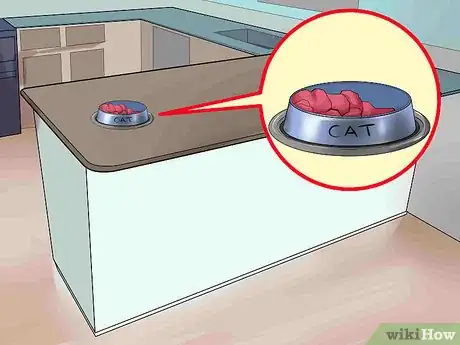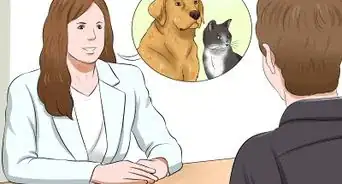This article was co-authored by Jessica Char. Jessica Char is a Cat and Dog Trainer, Behavior Consultant, and the Founder of Feline Engineering and Canine Engineering. She specializes in modifying challenging pet behavior problems, such as fear and aggression, using positive reinforcement training protocols. Jessica is a Certified Fear Free Trainer, a Certified Professional Dog Trainer, and a Certified Separation Anxiety Trainer. She is also a member of the International Association of Animal Behavior Consultants. Jessica received her BS and MS in Biomedical Engineering from Washington University in St. Louis.
There are 8 references cited in this article, which can be found at the bottom of the page.
This article has been viewed 36,712 times.
The stereotype states that cats and dogs never get along and always end up fighting. However, this doesn’t have to be the case. You can get your cat used to a new puppy by carefully choreographing their initial introductions. Ensuring that each animal has their own private space to roam, eat, and sleep is another way to help the relationship form. Try to stay positive throughout the process and offer affection and treats to both your cat and dog.
Steps
Making the Initial Introductions
-
1Introduce your puppy’s scent into your home. Take a few toys or blankets that have been touched by the puppy and place them throughout your house. You can also wipe down your couch or other furniture with a towel that you used to rub on the puppy. Animals communicate through scent and this will provide an introduction before the two even meet.[1]
- Whenever the puppy moves in you can continue this process by placing scented towels, from both animals, in the food or play areas of the other one. This will not generally trigger territorial impulses but will increase familiarity instead.[2]
-
2Choose a peaceful time for the first meeting. Don't try to introduce them when friends or many people are around. Avoid times when you are stressed, such as right after you come home from work. Animals can sense your stress and they can also behave differently due to stress as well. When you finally bring the puppy into your house make sure that you haven’t recently moved or undergone any other major life change too.Advertisement
-
3Confine the puppy to a particular area for a bit. Place your new puppy in a separate room or living space (blocked off by baby gates) for a few days.[3] Put their kennel and food/drink in the same place. This will allow your cat to get to know the new arrival without the stress of meeting face-to-face. Observe the reactions of both animals to gauge how a final introduction might go.
- Even after the two have met, it is a good idea to observe all interactions closely. Your puppy, depending on its size, may be able to injure your cat without even meaning to do so.[4]
-
4Put the puppy on a lead. When you take your puppy out of its designated space, go ahead and put a halter or lead on it.[5] This will allow you to control the movement of the puppy, thus ensuring your cat’s safety. It is also okay to put your cat on a leash if you feel that this will add to their safety.
- It is important to prevent the puppy from chasing the cat because if the puppy is allowed to do it once, then he will want to do it again. Try distracting the puppy with one of his favorite toys and praise him for ignoring the cat.
- With an older dog, you can also give them the "sit" command and then do some obedience training while the cat is at a distance. This will teach your dog to pay attention to you rather than the cat.
-
5Don’t force contact. As the home’s first resident, it is best to let your cat decide when, and how, to approach your new puppy. It is not a good idea to hold or dangle your cat near to your dog, as this may prompt your cat to strike out in fear. This also sets a stage for future interactions dominated by fear instead of positive feelings and curiosity.[6]
-
6Invite a dog training professional into your home. If your cat is particularly nervous about newcomers, or if you are simply worried about the process, it may be a good idea to contact a dog trainer in your area who can facilitate the introduction process. Talk with your vet to get a good reference.[7]
- Before the trainer arrives take a moment to write down your primary concerns. Are you worried that the two animals will harm one another? Are you concerned about your cat’s emotional well-being?
Giving Each Animal Their Own Space
-
1Move your cat’s food to a protected location. Puppies and dogs love to eat cat food. However, cat food is so protein-rich that it often causes serious digestive issues for dogs. Take your cat’s food and water bowls are relocate them to an area where the puppy will not be able to access or reach. Perhaps move them to a countertop. Or, to a separate cat-only room.[8]
- This will also make your cat feel less vulnerable as it eats. A bouncy puppy pouncing on them can be so stressful that some cats will forgo eating entirely, causing a whole other set of problems.
- It is also a good idea to keep your cat away from your new puppy when it is eating as well. Your puppy could lash out in a bout of food protectiveness and potentially injure your cat.
-
2Move your cat’s litter pan to a protected location. Puppies and dogs also love to eat cat feces, oddly (and grossly) enough. Get a box with a closing too small for your puppy to enter or one with a cat flap. You could also put the box in a cat-only room or use baby gates to create a barrier around the box area.[9]
- Your cat is very vulnerable when using their box. If they feel unsafe, they might start using the restroom elsewhere out of a feeling of self-preservation. Once this outside marking starts, it is very difficult to stop.
-
3Provide high-rise hideaways for your cat. Most cats are climbers or hiders. Take a look at your home and make sure that there are ample spots for your cat to escape from the puppy, if desired. You can place bookcases in an accessible way. You can also clear a path to window sills and counters. Some pet stores even sell specialty cat climbers that you can install on your walls.[10]
- Make sure that each room has at least one high-rise escape route for your cat. This will help to prevent a direct confrontation.
-
4Install baby gates. Your puppy does not need to have the full run of your home. You can put baby gates in certain doorways or hallways in order to limit your puppy’s access. Your cat will then learn which areas are protected and which are open access. If your cat cannot jump over these barriers, then you will want to use them more sparingly.[11]
-
5Consider crating the puppy. Putting your puppy in a crate for short periods of time can actually be a good thing for your puppy, you, and your cat.[12] It teaches the puppy control. It gives you a break. And, it gives your cat a puppy-free period of time, as it used to be. Place your puppy in the crate and then issue the “Quiet” command.[13]
- Don’t let your cat pester your puppy while it is in the crate. This will keep your puppy agitated and will make the crate seem more like a punishment then a training tool.
Encouraging Positive Behaviors and Interactions
-
1Be patient. Relationships take time to form and this situation is no different. Don’t expect your cat to instantly love your puppy or vice versa. Instead, try to get them to get along first in a safe manner and then keep your fingers crossed for something more to develop.
-
2Share your attention. Your cat will expect the same treatment that it experienced before, so make sure to keep up the cuddling and treating. Make sure that both your puppy and cat have sufficient toys to play with. And, watch to make sure that toy stealing is minimized. As your cat and puppy behave nicely, make sure to praise them by offering treats and saying, “good job!”
- Get all of your family members involved. Everyone can help to make sure that both your cat and dog are healthy and happy with one another.[14]
-
3Enroll your puppy in obedience classes. Search for a class in your area by typing your city’s name and “puppy obedience courses” into a search engine. Then, take your puppy on a regular basis. They will learn a variety of useful commands, such as “leave it.” These commands can be used if they get out of control when around your cat. This is also a great way to expend a puppy’s natural energy.
-
4Recognize your cat’s stress behaviors. Keep a close eye on your cat during the first few weeks of puppy cohabitation. Your cat may appear fine on the surface, but could be subtly indicating that they are stressed. Watch to see if your cat is marking the furniture (by scratching or spraying). They may also be using the restroom in hidden places, like the corners of your closet. Your cat may also show more obvious stress by hissing or arching its back.[15] [16]
- Another warning sign is a lack of grooming. If your cat stops grooming itself, this could mean that it doesn't feel safe doing so with the puppy around. Make sure to give your cat a safe space to tend to these needs.
-
5Individualize the problems that you see. Try to adopt an attentive, not a dismissive, attitude. You may see that your cat is only aggressive when the puppy enters a certain room or approaches a particular family member. Or, you may notice that your puppy is only snippy when your cat tries to steal a certain toy. Tailor your responses according to the particular issues that you see.[17]
-
6Talk to your veterinarian. As you bring both your puppy and cat in for their annual visits, discuss with your vet how the animals are getting along. Ask any questions that you have and try to get as much advice as you can.
- For example, you might say, “How can I keep the puppy from tearing up all of my cat’s toys?”
Warnings
- It may be a good idea to clip your cat’s claws, at least slightly. This may cut down on their defense a bit, but it can keep your puppy from being injured as well.⧼thumbs_response⧽
- Expect some rough patches as your two animals learn to live together. Just keep a careful eye on what is happening and adjust your training methods as needed.⧼thumbs_response⧽
References
- ↑ http://cleverdogcompany.com/introducing-your-puppy-and-cat/
- ↑ https://www.paws.org/library/cats/home-life/introducing-cat-to-dog/
- ↑ Jessica Char. Cat & Dog Behaviorist.
- ↑ https://www.paws.org/library/cats/home-life/introducing-cat-to-dog/
- ↑ Jessica Char. Cat & Dog Behaviorist.
- ↑ http://pets.webmd.com/cats/features/when-dog-and-cat-meet?page=2
- ↑ http://cleverdogcompany.com/introducing-your-puppy-and-cat/
- ↑ http://cleverdogcompany.com/introducing-your-puppy-and-cat/
- ↑ http://cleverdogcompany.com/introducing-your-puppy-and-cat/
- ↑ http://cleverdogcompany.com/introducing-your-puppy-and-cat/
- ↑ http://cleverdogcompany.com/introducing-your-puppy-and-cat/
- ↑ Jessica Char. Cat & Dog Behaviorist.
- ↑ https://www.petfinder.com/dogs/dog-training/socializing-puppy/
- ↑ http://www.vetstreet.com/dr-marty-becker/integrating-a-younger-pet-with-an-older-pet?page=2
- ↑ Jessica Char. Cat & Dog Behaviorist.
- ↑ http://cleverdogcompany.com/introducing-your-puppy-and-cat/
- ↑ http://bestfriends.org/resources/how-introduce-dog-cat
- ↑ http://www.catster.com/lifestyle/cats-and-dogs-can-get-along-heres-how
About This Article
To get your cat used to your new puppy, first let your puppy play with some toys and blankets and then place these around the house so your cat can become familiar with its scent. When it’s time to bring your puppy into your home, put it in a separate space for a while so your cat can meet it without the stress of being face-to-face. Eventually, when you take your puppy out of this space, use a lead to ensure your cat’s safety. Remember to let your cat approach your puppy on its own so it doesn’t feel forced and act aggressively out of fear. To help your cat feel even safer around your new puppy, move its food and litter pan to a separate area your puppy can’t access. For more tips from our Veterinary co-author, including how to recognize if your cat is feeling stressed from interacting with the new puppy, read on!










































































